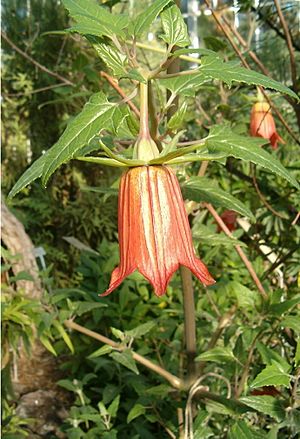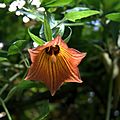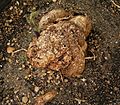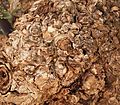Canarina canariensis facts for kids
Quick facts for kids Canarina canariensis |
|
|---|---|
 |
|
| Scientific classification | |
| Genus: |
Canarina
|
| Species: |
canariensis
|
The Canarina canariensis is a beautiful flowering plant often called the Canary Island bellflower. In its home, the Canary Islands, people know it as bicácaro. It belongs to the bellflower family, Campanulaceae.
Contents
What Does the Canary Island Bellflower Look Like?
This plant is a perennial herb, which means it lives for more than two years. It has stems that climb and spread out, reaching about 3 meters (10 feet) long. These stems grow new each year from a thick, potato-like root underground.
Leaves, Flowers, and Fruit
The leaves of the Canary Island bellflower are smooth and have a grey-green color. They grow in pairs and are shaped like triangles or arrowheads with jagged edges.
Its flowers are bell-shaped and grow one by one from where the leaves meet the stem. They are usually 3 to 6 centimeters (1 to 2.5 inches) long and are a bright orange color. When the flowers dry, their color gets darker.
After the flowers, the plant grows a large, round fruit that looks like a berry. When it's ripe, this fruit turns orange and is safe to eat.
How Does it Get Pollinated?
Birds help this plant make new seeds! Small birds, like the Canary Islands chiffchaff, visit the flowers. As they drink nectar, they carry pollen from one flower to another. This process is called pollination.
Where Does the Canary Island Bellflower Grow?
The Canary Island bellflower is special because it only grows naturally in the Canary Islands. This means it is endemic to these islands. You can find it in different parts of the islands:
- Tenerife: It's common in laurel forests and at the edges of forests. You can see it in the Anaga region and along the north coast, usually between 300 and 1000 meters (about 1,000 to 3,300 feet) high.
- Gran Canaria: This plant grows in the laurel woods of Los Tiles de Moya. It used to be more common in other areas like San Mateo and Santa Brigida, but now there are fewer plants there.
- La Palma: You can find it in open areas within laurel forests or where parts of these old forests still remain.
- La Gomera: It is quite rare in the forest regions of this island.
- El Hierro: It grows in places like Frontera and Las Playas.
Growing the Canary Island Bellflower
People like to grow the Canary Island bellflower in gardens because of its climbing habit and its beautiful orange bell-shaped flowers.
However, this plant doesn't like cold weather. It cannot survive temperatures below 0 degrees Celsius (32 degrees Fahrenheit). So, in places with cold winters, people usually grow it indoors in a greenhouse or a warm room. It can grow up to 1.5 meters (5 feet) tall when cultivated.
In the UK, the Royal Horticultural Society has given it an Award of Garden Merit. This award means it is a great plant for gardeners to grow.
Images for kids
See also
 In Spanish: Bicácaro para niños
In Spanish: Bicácaro para niños

















